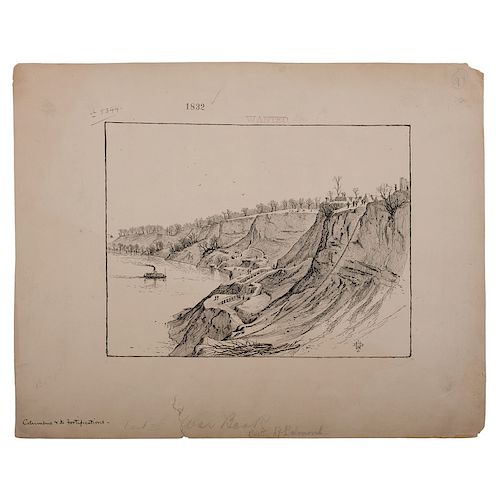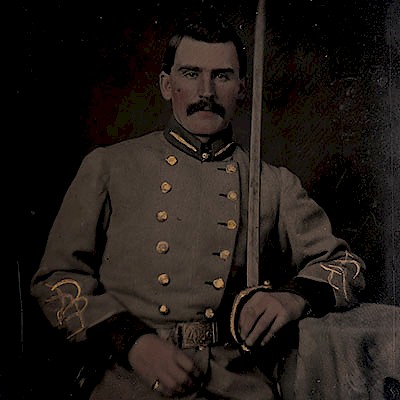Confederate Fortifications at Columbus, Kentucky, November 1861, Pen and Ink Sketch by J.D. Woodward
About Seller
6270 Este Ave.
Cincinnati , OH 45232
United States
With offices in Cincinnati, Cleveland and Denver, Cowan’s holds over 40 auctions each year, with annual sales exceeding $16M. We reach buyers around the globe, and take pride in our reputation for integrity, customer service and great results. A full-service house, Cowan’s Auctions specializes in Am...Read more
Two ways to bid:
- Leave a max absentee bid and the platform will bid on your behalf up to your maximum bid during the live auction.
- Bid live during the auction and your bids will be submitted real-time to the auctioneer.
Bid Increments
| Price | Bid Increment |
|---|---|
| $0 | $25 |
| $500 | $50 |
| $1,000 | $100 |
| $2,000 | $250 |
| $5,000 | $500 |
| $10,000 | $1,000 |
| $20,000 | $2,500 |
| $50,000 | $5,000 |
| $100,000 | $10,000 |
About Auction
Jun 22, 2018
Cowan’s American History: Premier Auction, scheduled for June 22, 2018 is comprised of early photographs, documents, manuscripts, broadsides, flags, and more dating from the Revolutionary War, the Civil War, Late Indian Wars, World War I and II and beyond. Cowan's Auctions dawnie@cowans.com
- Lot Description
Pen and ink on board, 9.5 x 7.5 in. Initialed lower right by J.D. Woodward. From a wartime sketch possibly by Rear Admiral Walke. These fortifications were across the Mississippi River from Belmont, Missouri, in and around which the Battle of Belmont was fought in November 1861. Published in Battles and Leaders of the Civil War, Vol. 1, p. 354. Good detail throughout.
John Douglas Woodward (American, 1846-1924) was considered one of America's best-known painters and illustrators, producing hundreds of scenes of the United States as well as Northern Europe, the Holy Land, and Egypt, many of which were reproduced in popular magazines of the day. He was born in Middlesex Co., VA, and moved at a very young age to Covington, KY. By 1861, around the age of 15 or 16, he began studying art under the German painter T.C. Welsch in nearby Cincinnati, OH. Woodward's family had Confederate sympathies and fled to Canada during the Civil War. However, in 1863, Woodward journeyed to New York City where he studied at Cooper Union and the National Academy of Design until 1865. Although he initially tried working exclusively as a landscape artist, Woodward found it quite challenging to earn a living as an artist and developed an interest in illustrating. By 1871, he received his first commission from Hearth and Home magazine, which took him on a sketching tour of the South. From that point on through the early 20th century, Woodward traveled throughout the United States, Europe, and beyond, finding great success as an illustrator and painter.
__________________________________________________________________________________________________________________
The David L. Hack Civil War Art Collection
Lots 172-181
While the photographic process evolved rapidly from its inception in 1839 and the wet plate process of taking photographs was coming into widespread use by the start of the Civil War, it was a cumbersome process in the field as well as the studio. More significantly, at that time the photographs themselves could not be reproduced as illustrations accompanying written reports of the war.
As a result, publishers of newspapers and other periodicals in major cities, primarily in the North, employed a number of sketch artists who traveled with armies to draw the scenes that they witnessed. These sketches, most frequently pencil on paper with brief identifications of people and places, were then sent back by courier to the periodical publishers. The battlefield sketches received by the publishers were then copied by engraving artists onto wooden blocks, which were used in printing presses to illustrate printed articles covering the war.
Unlike the photographers of the day, who were limited to capturing the aftermath of battles, the sketch artists had the advantage of recording what they were witnessing as the events occurred before their eyes.
Lots 174-180 feature the original artwork of noted battlefield artist Alfred R. Waud (1828-1891). Born and raised in London, Waud studied at the Government School of Design at Somerset House before immigrating to the United States in 1850. Upon his arrival, Waud worked primarily as a freelance artist until May of 1861 when he was retained as a sketch artist and special correspondent by the New York Illustrated Newspaper to report on the war. At the close of 1861, Waud joined Harper's Weekly, where he was employed through the end of the war. He continued to work for Harper's Weekly in addition to a number of other publishers following the war and his career flourished. While touring battlefields in the South in 1891, Waud died in Marietta, GA. The Library of Congress houses most of his original wartime sketches, with some remaining in private hands.
In the 1880s, the popular Century Magazine started publishing the narratives of Civil War veterans and retained a large number of sketch artists including Waud to illustrate the articles. They used interviews, photographs, and prior war-date sketches to produce accurate pictorial representations of the war. These illustrated accounts were incorporated into a large four-volume work entitled Battles and Leaders of the Civil War in 1881. Almost a century later, in 1973, American Heritage Magazine acquired the collection of drawings that had been held by Century Magazine, which were subsequently reproduced in The American Heritage Century Collection of Civil War Art published in 1974. Christie's conducted two public auctions in 1988, which were comprised of the remaining original Century Magazine Collection of Civil War artwork that was dispersed by American Heritage Magazine, and a number of drawings by Waud were acquired by the consignor, with many being offered today.
Tear in bottom of board not intruding on subject. Publisher's numbers and stamp at top of board and pencil and ink inscriptions at bottom.Condition
Eliminate the Hassle of Third-Party Shippers: Let Cowan's Ship Directly To You!
If you'd like a shipping estimate before the auction, contact Cowan's in-house shipping department at shipping@cowans.com or 513.871.1670 x219. - Shipping Info
-
Buyers are required to pay for all packing, shipping and insurance charges. Overseas duty charges are the responsibility of the successful Bidder. Be aware that for larger and/or valuable items, shipping charges can be substantial. - If there is no shipping amount on listed your invoice, you will need to make arrangements to pick up or ship your purchase through an alternative shipping company. Our shipping department can be contacted at 513.871.1670 (ext. 219) or email shipping@cowans.com. - Shipping charges include insurance for your order while in transit. If you have private insurance we will adjust your charge to include only packing and shipping. - Please allow 14 – 21 days after payment to package and ship your purchase as carefully as possible.
-
- Buyer's Premium



 EUR
EUR CAD
CAD AUD
AUD GBP
GBP MXN
MXN HKD
HKD CNY
CNY MYR
MYR SEK
SEK SGD
SGD CHF
CHF THB
THB











